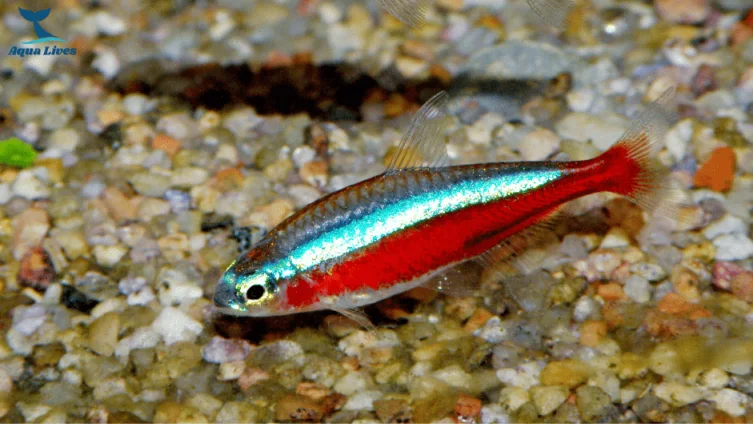The scientific name of the Cardinal Tetra is Paracheirodon axelrodi.
Origin and Natural Habitat
Cardinal Tetras are native to the Amazon Basin in South America. They thrive in slow-moving rivers and streams with dense vegetation and soft, acidic water. These environments provide plenty of hiding spots and food sources, making them ideal for the vibrant Cardinal Tetra.
Appearance
Cardinal Tetras are known for their striking appearance, featuring bright red and blue stripes along their bodies. They have sleek and slender body. Their vivid colors and small size make them popular for home aquariums.
Cardinal Tetra Male vs Female
Male Cardinal Tetra:
- Brighter and more intense red and blue colors.
- Slimmer and more streamlined body shape.
- Display enhanced coloration, especially during breeding.
Female Cardinal Tetra:
- Slightly rounder body shape.
- Less vibrant red and blue colors compared to males.
- Generally, they exhibit more subdued coloration.
- It may appear larger, especially when carrying eggs.
Cardinal Tetra Care
Cardinal Tetra care is relatively simple and rewarding. You can ensure their health and longevity in your aquarium by providing a suitable environment and proper care.
Water Conditions:
- Maintain clean and well-filtered water.
- Keep the water temperature between 72-82°F (22-28°C).
- Aim for a pH level between 5.5 and 7.5.
Tank Size Recommendations:
- Provide a spacious tank with a minimum capacity of 10 gallons.
- Larger tanks are preferred, especially for larger groups of Cardinal Tetras.
Ideal Temperature and pH Levels:
- Keep the water temperature stable within the recommended range.
- Monitor and adjust pH levels to ensure they remain within the suitable range for Cardinal Tetras.
Decoration and Substrate Preferences:
- Use fine gravel or sand substrate to mimic their natural habitat.
- Include live plants and driftwood to provide hiding spots and mimic their natural environment.
Social Environment:
- Keep Cardinal Tetras in groups of six or more to promote their natural schooling behavior.
- Avoid keeping them with aggressive tank mates that may stress or harass them.
Cardinal Tetra Tank Mate:
Cardinal Tetras are peaceful fish that thrive in community aquariums. They get along well with other small, peaceful species with similar water conditions. Here are some ideal tank mates:
- Neon Tetra
- Corydoras Catfish
- Dwarf Gouramis
- Harlequin Rasboras
- Otocinclus Catfish
- Ember Tetras
- Honey Gouramis
- Cherry Shrimp
Cardinal Tetra food:
Cardinal Tetras are omnivores, meaning they eat plant and animal matter. Here’s what you should know about feeding them:
- Omnivorous Diet: Cardinal Tetras eat various foods, including plant-based flakes or pellets and small live or frozen foods like bloodworms and brine shrimp.
- Food Types: Offer them high-quality flake or micro-pellet food formulated for tropical fish. Supplement their diet with occasional treats such as bloodworms, brine shrimp, and daphnia.
- Feeding Schedule: Feed them small portions 2-3 times a day, enough that they can consume within 2-3 minutes. This helps maintain water quality and prevents overfeeding.
Feeding Tips: Rotate their diet to ensure balanced nutrition. Monitor their eating habits and remove any uneaten food promptly to keep the tank clean and healthy.
Behavior
Cardinal Tetras are known for their peaceful behavior and vibrant appearance, making them a favorite in community aquariums. They’re active swimmers and often stay in the middle or upper parts of the tank, showcasing their bright red and blue colors. They thrive in groups of six or more, displaying natural schooling behavior that adds liveliness to any aquarium. Cardinal Tetras contribute to a serene and balanced aquatic environment when kept with compatible tankmates—such as other small, calm fish.
Breeding Cardinal Tetra
Breeding Cardinal Tetra is an intriguing process for aquarium enthusiasts. Here’s a simple guide:
- Breeding Behavior: Cardinal Tetras exhibits courtship displays in which males chase females. Breeding often occurs in dimly lit areas among plants.
- Spawning: Females scatter adhesive eggs on plant leaves or other surfaces. Males fertilize the eggs as they are laid.
- Egg Care: Remove adult tetras after spawning to prevent them from eating the eggs. Eggs hatch within 24-36 hours.
- Fry Rearing: Initially, feed small foods like infusoria or liquid fry food. As they grow, transition to baby brine shrimp or crushed flakes.
- Breeding Tank Setup: Use a separate breeding tank with plants or spawning mops. Maintain stable conditions with slightly warmer temperatures (78-80°F or 25-27°C) and subdued lighting to simulate natural conditions.
Health and Disease Prevention
- Common Diseases: Cardinal Tetras are susceptible to aquarium illnesses, such as ich (white spot disease), fin rot, and fungal infections.
- Symptoms: Look out for signs such as white spots, frayed fins, or unusual growths on their bodies.
Prevention:
- Maintain clean water conditions through regular water changes and monitoring of water parameters.
- Quarantine new fish before introducing them to the main tank to prevent disease transmission.
Treatment: If signs of illness appear, promptly isolate affected fish and treat them with appropriate medications under veterinary guidance.
Final Words
Caring for Cardinal Tetras involves providing them with stable water conditions, suitable tank mates, and a balanced diet. Their vibrant colors and peaceful nature make them a delightful addition to any home aquarium. By following the recommended care tips and monitoring their health closely, you can enjoy the beauty of Cardinal Tetras while ensuring their well-being. Consider adding these charming fish to your aquarium and experience the joy they bring to your aquatic hobby.

